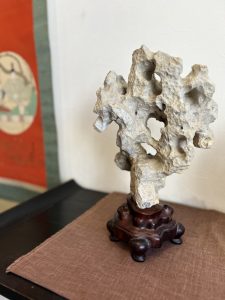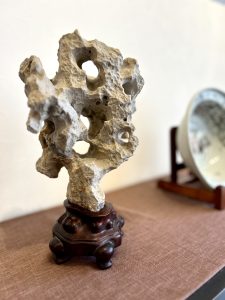想像力を試されている気がします(愛知県名古屋市千種区姫池通 骨董買取 古美術風光舎)
2024.02.27
皆さまこんにちは。スタッフHでございます。
連休はどのように過ごされたでしょうか。我が家は大々的に家の片付けをいたしまして、気持ちが晴れ晴れとしております。片付けが面倒で見て見ぬふりをしていましたが、無意識下でかなり負担に感じていたのかもしれません。懐かしいものや、何故保管していたのか理解できない品もたくさん出てきました。自分にとって本当に必要なものは何かを考えさせられます。
さて、古来より中国の文人は石を生涯の友とまで呼び、大切にしていたといいます。机上の装飾品として愛で、詩に詠んでいたということです。中国では「鑑賞石」という文化があり、現代でも石愛好家は多く、石の模様を山水画に見立て楽しんでいるそうです。
風光舎店内にも太湖石と呼ばれる石がございます。足元が細く絶妙なバランスで立っております。

太湖石とは中国蘇州のかつて内海だった太湖から産出された石灰岩の奇石です。長年、湖水や風雨の浸食を受けて石の表面にくぼみや孔穴のある複雑な形をしています。自然が作り出す芸術品として珍重されてきました。
太湖石の発見者は唐代の詩人、白居易(白楽天)であるという説もあり、愛好家として知られています。宋代には太湖石を峰に見立てて庭園に飾ったり、書斎の装飾品としても用いられました。また絵画や工芸品にも描かれるなど大変人気のあるモチーフだったとのことです。
鑑賞ポイントは諸説あるそうですが、有名なところで「痩、漏、皺、透」という基準があるとのこと。痩は細く長いこと、自立していること。漏は複雑に穴が開いていること。皺は石肌がよく、皺や模様に趣があること。透は大小の穴から奥の景色がみえることだそうです。最高ランクの物は皇帝や貴族たちがこぞって集めたと言われています。
しかしその独特な珍しい形は目を楽しませるためだけのものではなかったようです。中国の文献によると、道教の視点から複雑にあいた穴が別世界への入り口であるとも考えられ、別世界が一つの太湖石の中にいくつも存在するとみなされたそうです。奇石はミニチュアの宇宙の集合体とも考えられ永遠の世界が凝縮していると想像を膨らませていたようです。
当時の人々にとっての宇宙は、今私が想像する宇宙とは比べ物にならないほど果てしなく、得体の知れない空間だったことでしょう。机に向かいながらそんな世界に心を馳せ、俗世から離れて自由な思考を楽しんだのでしょうか。覗いているのは穴の向こうなのか、それとも自分の頭の中なのか。いずれにしても見る側の想像力が試される気がいたします。

日本でも中国の影響を受け、太湖石を絵画や工芸品のモチーフとして取り入れられています。伊万里焼でも初期伊万里以来、柿右衛門式様式、金襴手様式で奇石の背面から花が伸びる構図の文様をみることができるとのこと。しかし時代と共に太湖石の描き方が簡素化していき、次第にただの丸で表されるようになったそうです。文様の中で、この丸いものは何だろうという疑問が湧いたら太湖石の名残かもしれませんね。
話は逸れますが、先日雛菓子をいただきました。食べるのが忍びないほど可愛いく、淡い色合いが春を感じさせてくれます。しばらく眺めて楽しみたいと思います。

それでは、また次の機会に。
Hello everyone. This is Staff H.
How did you spend the holidays? We cleaned up our house extensively, and we are feeling refreshed. I pretended to ignore it because it was a hassle to clean up, but I may have unconsciously felt it was quite a burden. I found many items that I missed and many items that I don’t understand why I kept. It makes me think about what is really necessary for me.
Now, since ancient times, Chinese literati even called stones their lifelong friends and cherished them. They loved them as desk ornaments and composed poems about them. In China, there is a culture of “appreciating stones,” and even today there are many stone lovers who enjoy the patterns on stones as if they were landscape paintings.
There is a stone called “Taihu Stone” in the Fukosha store. It stands with a slender foot and is exquisitely balanced.
Taihu Stone is an unusual limestone stone produced from Taihu Lake, which used to be an inland sea in Suzhou, China. Over the years, the lake water and wind and rain have eroded the stone into intricate shapes with hollows and holes on the surface. It has been prized as a work of art created by nature.
Some say that Taihu Stone was discovered by the Tang Dynasty poet Bai Juyi (Bai Le Tian), who is known as a connoisseur of the stone. During the Song dynasty (960-1279), Taihu Stone was used as a peak in gardens and as an ornament in study rooms. It was also a very popular motif in paintings and crafts.
There are various theories on how to appreciate the stone, but the most well-known are the following criteria: slenderness, leakiness, wrinkles, and translucency. Slender means long and thin, and freestanding. Leakage is a complicated hole in the surface. Wrinkles are those with good stone skin, and the wrinkles and patterns have a certain elegance. The word “toru” means that the view from the back can be seen through the holes of various sizes. It is said that the highest-grade pieces were collected by emperors and aristocrats.
However, their unique and unusual shapes were not meant to please the eye. According to Chinese literature, from a Taoist perspective, the intricate holes were thought to be portals to other worlds, and other worlds were considered to exist within a single taihu stone. The odd stones were also thought to be miniature collections of universes, and people imagined that the eternal worlds were condensed in them.
The universe for the people of that time must have been an endless, unfathomable space far beyond anything we can imagine today. They must have enjoyed the freedom of thinking about such a world away from the mundane world as they sat at their desks. Was he peering through a hole or into his own head? Either way, I feel that the viewer’s imagination is put to the test.
Influenced by China, Japanese people have also adopted taiko-seki as a motif in their paintings and crafts. In Imari ware, since the early Imari period, Kakiemon style and Kinrande style have also been used to depict flowers extending from the back of the strange stones. However, as time went by, the drawing of taiko-seki became simpler, and it gradually came to be represented as a simple circle. If you wonder what these circles are in the design, they may be the remnants of Taihu Stone.
This is a digression, but the other day I received some hina festival sweets. They are so cute that I can hardly bear to eat them, and their pale colors are indescribably beautiful. I would like to enjoy looking at them for a while.
See you next time.
*******************
ご実家の整理やお片付けなどをされている方のご相談などが多くございます。
お片付けなどくれぐれもご無理のないようになさってくださいませ。
風光舎では古美術品や骨董品の他にも絵画や宝石、趣味のお品など様々なジャンルのものを買受しております。
お片付けをされていて、こういうものでもいいのかしらと迷われているものでも、どうぞお気軽にご相談下さいませ。
また風光舎は、出張買取も強化しております。ご近所はもちろん、愛知県内、岐阜県、三重県その他の県へも出張いたします。
まずは、お電話お待ちしております。
愛知県名古屋市千種区姫池通
骨董 買取【古美術 風光舎 名古屋店】
TEL052(734)8444
10:00-18:00 OPEN
#骨董買取#古美術買取#出張買取#無料査定#生前整理#遺品整理#家じまい#実家じまい#掛け軸#絵画#木箱入り茶碗#刀剣#洋食器#貴金属

